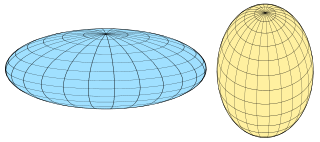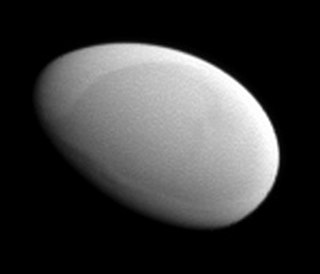In astronomy, the plutinos are a dynamical group of trans-Neptunian objects that orbit in 2:3 mean-motion resonance with Neptune. This means that for every two orbits a plutino makes, Neptune orbits three times. The dwarf planet Pluto is the largest member as well as the namesake of this group. The next largest members are Orcus, (208996) 2003 AZ84, and Ixion. Plutinos are named after mythological creatures associated with the underworld.

In celestial mechanics, the Roche limit, also called Roche radius, is the distance from a celestial body within which a second celestial body, held together only by its own force of gravity, will disintegrate because the first body's tidal forces exceed the second body's gravitational self-attraction. Inside the Roche limit, orbiting material disperses and forms rings, whereas outside the limit material tends to coalesce. The Roche radius depends on the radius of the first body and on the ratio of the bodies' densities.

A spheroid, also known as an ellipsoid of revolution or rotational ellipsoid, is a quadric surface obtained by rotating an ellipse about one of its principal axes; in other words, an ellipsoid with two equal semi-diameters. A spheroid has circular symmetry.

An ellipsoid is a surface that may be obtained from a sphere by deforming it by means of directional scalings, or more generally, of an affine transformation.

Figure of the Earth is a term of art in geodesy that refers to the size and shape used to model Earth. The size and shape it refers to depend on context, including the precision needed for the model. The sphere is an approximation of the figure of the Earth that is satisfactory for many purposes. Several models with greater accuracy have been developed so that coordinate systems can serve the precise needs of navigation, surveying, cadastre, land use, and various other concerns.

STS-87 was a Space Shuttle mission launched from Launch Complex 39B of the Kennedy Space Center on 19 November 1997. It was the 88th flight of the Space Shuttle and the 24th flight of Columbia. The mission goals were to conduct experiments using the United States Microgravity Payload (USMP-4), conduct two EVAs, and deploy the SPARTAN-201 experiment. This mission marked the first time an EVA was performed from Columbia. An EVA from Columbia was originally planned for STS-5 in 1982 but was canceled due to spacesuit problems. It also marked the first EVA conducted by a Japanese astronaut, Takao Doi.

In geodesy, a reference ellipsoid is a mathematically defined surface that approximates the geoid, which is the truer, imperfect figure of the Earth, or other planetary body, as opposed to a perfect, smooth, and unaltered sphere, which factors in the undulations of the bodies' gravity due to variations in the composition and density of the interior, as well as the subsequent flattening caused by the centrifugal force from the rotation of these massive objects . Because of their relative simplicity, reference ellipsoids are used as a preferred surface on which geodetic network computations are performed and point coordinates such as latitude, longitude, and elevation are defined.

Laetitia is a large main-belt asteroid that was discovered by French astronomer Jean Chacornac on 9 February 1856 and named after Laetitia, a minor Roman goddess of gaiety. The spectrum matches an S-type, indicating a stony (silicate) composition. It is orbiting the Sun with a period of 4.61 years and is spinning on its axis once every 5.1 hours.

Methone is a small, egg-shaped moon of Saturn that orbits out past Saturn's ring system, between the orbits of Mimas and Enceladus. It was discovered in 2004, though it wasn't until 2012 that it was imaged in detail by the Cassini spacecraft.
Schuler tuning is a design principle for inertial navigation systems that accounts for the curvature of the Earth. An inertial navigation system, used in submarines, ships, aircraft, and other vehicles to keep track of position, determines directions with respect to three axes pointing "north", "east", and "down". To detect the vehicle's orientation, the system contains an "inertial platform" mounted on gimbals, with gyroscopes that detect motion connected to a servo system to keep it pointing in a fixed orientation in space. However, the directions "north", "east" and "down" change as the vehicle moves on the curved surface of the Earth. Schuler tuning describes the conditions necessary for an inertial navigation system to keep the inertial platform always pointing "north", "east" and "down", so it gives correct directions on the near-spherical Earth. It is widely used in electronic control systems.
The invariable plane of a planetary system, also called Laplace's invariable plane, is the plane passing through its barycenter perpendicular to its angular momentum vector. In the Solar System, about 98% of this effect is contributed by the orbital angular momenta of the four jovian planets. The invariable plane is within 0.5° of the orbital plane of Jupiter, and may be regarded as the weighted average of all planetary orbital and rotational planes.

The scattered disc (or scattered disk) is a distant circumstellar disc in the Solar System that is sparsely populated by icy small solar system bodies, which are a subset of the broader family of trans-Neptunian objects. The scattered-disc objects (SDOs) have orbital eccentricities ranging as high as 0.8, inclinations as high as 40°, and perihelia greater than 30 astronomical units (4.5×109 km; 2.8×109 mi). These extreme orbits are thought to be the result of gravitational "scattering" by the gas giants, and the objects continue to be subject to perturbation by the planet Neptune.

The square planar molecular geometry in chemistry describes the stereochemistry that is adopted by certain chemical compounds. As the name suggests, molecules of this geometry have their atoms positioned at the corners.

Explorer 52, also known as Hawkeye-1, Injun-F, Neutral Point Explorer, IE-D, Ionospheric Explorer-D, was a NASA satellite launched on 3 June 1974, from Vandenberg Air Force Base on a Scout E-1 launch vehicle.

The Moon orbits Earth in the prograde direction and completes one revolution relative to the Vernal Equinox and the stars in about 27.32 days and one revolution relative to the Sun in about 29.53 days. Earth and the Moon orbit about their barycentre, which lies about 4,670 km (2,900 mi) from Earth's center, forming a satellite system called the Earth–Moon system. On average, the distance to the Moon is about 385,000 km (239,000 mi) from Earth's center, which corresponds to about 60 Earth radii or 1.282 light-seconds.

Spacecraft magnetometers are magnetometers used aboard spacecraft and satellites, mostly for scientific investigations, plus attitude sensing. Magnetometers are among the most widely used scientific instruments in exploratory and observation satellites. These instruments were instrumental in mapping the Van Allen radiation belts around Earth after its discovery by Explorer 1, and have detailed the magnetic fields of the Earth, Moon, Sun, Mars, Venus and other planets and moons. There are ongoing missions using magnetometers, including attempts to define the shape and activity of Saturn's core.

In geometry, the major axis of an ellipse is its longest diameter: a line segment that runs through the center and both foci, with ends at the two most widely separated points of the perimeter. The semi-major axis is the longest semidiameter or one half of the major axis, and thus runs from the centre, through a focus, and to the perimeter. The semi-minor axis of an ellipse or hyperbola is a line segment that is at right angles with the semi-major axis and has one end at the center of the conic section. For the special case of a circle, the lengths of the semi-axes are both equal to the radius of the circle.
Attitude control is the process of controlling the orientation of an aerospace vehicle with respect to an inertial frame of reference or another entity such as the celestial sphere, certain fields, and nearby objects, etc.
A planetary coordinate system is a generalization of the geographic coordinate system and the geocentric coordinate system for planets other than Earth. Similar coordinate systems are defined for other solid celestial bodies, such as in the selenographic coordinates for the Moon. The coordinate systems for almost all of the solid bodies in the Solar System were established by Merton E. Davies of the Rand Corporation, including Mercury, Venus, Mars, the four Galilean moons of Jupiter, and Triton, the largest moon of Neptune.
















